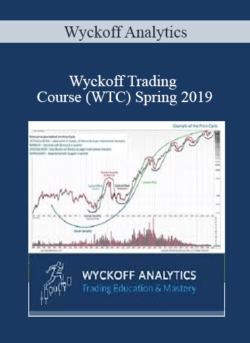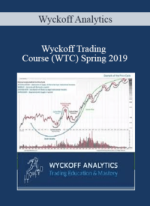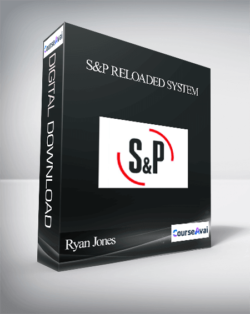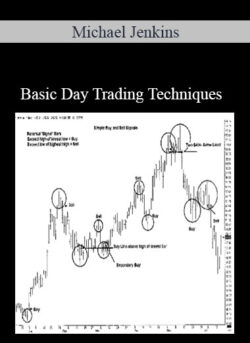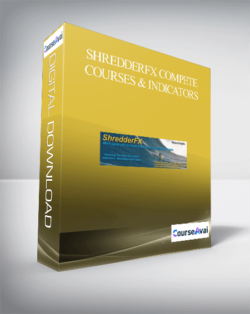Delivery Method: Deliver digital download link to your email after successful paymentThe previous sections of the WTC incorporate foundational elements of the Wyckoff Method and are designed to allow you to immediately apply standalone concepts to your own trading. For students who want to integrate these elements more deeply, Mr. Bogomazov teaches how to create a Wyckoff trading plan in the final three WTC sessions.Purchase Wyckoff Analytics – Wyckoff Trading Course (WTC) Spring 2019 courses at here with PRICE $998 $104WYCKOFFANALYTICS – WYCKOFF TRADING COURSE (WTC) (Spring 2019) (Jan-Apr)In the first four sessions of the WTC, you will learn how to to read market structure by applying Wyckoff’s cardinal insights regarding the interplay of price, volume and time. Understanding market structure allows you to anticipate coming price action. You will learn to identify and analyze accumulation, distribution, re-accumulation and re-distribution – the key trading ranges that power trends. You will also learn Wyckoff Method trade set-ups based on market structure, how to enter a new or an existing trend, and how to recognize in advance when a trend is likely to end.The Price Cycle: Accumulation, Mark-Up, Distribution and Mark-DownChange of Character in an established trend: identifying a change from a trending to a non-trending environmentChange of Character in a trading range: identifying price and volume action signaling the initiation or continuation of a trendTrading ranges that generate big trends: accumulation and distributionA key concept in Wyckoff Method analysis of trading ranges: PhasesPhase anatomy: Wyckoff Method events (e.g., climaxes, tests, springs, upthrusts, signs of strength)Identifying phases in accumulation and distributionCharacteristics of re-accumulation and re-distribution trading rangesDistinguishing re-accumulation from distribution and re-distribution from accumulationThree Wyckoff Method rules for trades based on market structureDelineating Buying and Selling Zones using the Wyckoff Method, including entry and exit strategiesExercises and homework assignmentsMini-course Duration: 4 online sessionsDates: Monday afternoons; January 7, 14, 21 and 28Time: 3:00-5:30 p.m. (Pacific Time)Cost: $998 for the entire January-April cycle (15 sessions); WTC alumni rate: $700 only for the whole course!To view a full free session of the Wyckoff Trading Course before you enroll,please (recording made on January 7, 2019). “Studying Wyckoff under Roman is one of the best decisions that I have made in my life. While progressing through the Wyckoff Trading Course, I earned 15x the money that I paid for tuition.” (PL – WTC graduate) WTC Part II (Spring 2019) – SUPPLY AND DEMAND: Here Mr. Bogomazov will focus in detail on identifying supply and demand on any chart. The Wyckoff Method is based on the assumption that all freely traded markets are governed by supply and demand. In today’s markets, as in Wyckoff’s time, large professional interests dominate supply and demand. Having the ability to accurately read supply and demand on a chart will allow you to make better decisions about timing your entries and exits and to join the large operators rather than being caught on the wrong side of a trade.Concepts in supply and demand – the forces that move all marketsWho is the composite operator and how do his actions in the market affect supply and demand?Volume and spread analysisVariations of spread and volume in different market environmentsEffort (volume) versus results (price action) – confirmation and discordance both predict future price behaviorVolume analysis and schematics in trading rangesVolume characteristics in different phases of accumulation and distributionWyckoff’s springboard: when price is poised to moveTradable volume patternsExercises and homework assignmentsMini-course Duration: 4 online sessionsDates: Monday afternoons; February 4, 11, 18, and 25Time: 3:00-5:30 p.m. (Pacific Time)Prerequisite: WTC Part I (Wyckoff Structural Price Analysis) or consent of instructor “Roman, without question, your instruction is exceptional and your patience endless. You have such a mastery of this material…[and] offer exceptional value both for the knowledge and time that is made available to students. There is no doubt that you walk in the noble footsteps of Wyckoff himself: developing and sharing knowledge without reserve.” (JC – WTC graduate and current WMD participant) WTC Part III (Spring 2019) – RELATIVE AND COMPARATIVE STRENGTH: Relative and comparative strength are Wyckoff Method concepts that can help you select the top stocks in the best sectors to trade, particularly at market turns. In this part of the course, you will learn how to apply these concepts to identify candidates for long or short trades, and how they can also be used to improve the timing of your entries and exits.Relative and comparative strength analysis: how to choose the best vehicles to tradeUse of comparative strength for stock selection in the Wyckoff MethodImproving the Wyckoff Method’s comparative strength analysis in trading rangesDifferences between relative and comparative performanceUsing changes in relative strength or weakness to spot sectors and stocks to tradeCreating selection filters using relative and comparative strength to identify high-probability tradesExercises and homework assignmentsMini-course Duration: 4 online sessionsDates: Monday afternoons; March 4, 11, 18, and 25Time: 3:00-5:30 p.m. (Pacific Time)Prerequisite: WTC Parts I and II (Wyckoff Structural Price Analysis and Supply and Demand) or consent of instructor “If you want to trade and trade well, the knowledge that you gain from the WTC is invaluable. You will really understand the price/volume action of the markets.”(DF – WTC graduate) WTC Part IV (Spring 2019) – PUTTING IT ALL TOGETHER: DEVELOPING A WYCKOFF TRADING PLAN: The previous sections of the WTC incorporate foundational elements of the Wyckoff Method and are designed to allow you to immediately apply standalone concepts to your own trading. For students who want to integrate these elements more deeply, Mr. Bogomazov teaches how to create a Wyckoff trading plan in the final three WTC sessions. Because the content of this section relies so heavily on materials presented previously, participation will be limited to students who have attended WTC Parts I, II and III.Using filters to improve selection of stocks or options to tradeRelative strength filtersStructural filtersSupply and demand filtersUsing multiple filters to pinpoint the best trades and times to open positionsMarket Analysis as a Filter – timing entries in sync with the marketUsing Wyckoff Method concepts to create a trading planBack-testing your trading plan with a pre-formatted Excel template – key variables to trackTrading tactics for your Wyckoff trading plan: entries, position management, and exitsExercises and homework assignmentsMini-course Duration: 3 online sessionsDates: Monday afternoons; April 1, 8 and 15Time: 3:00-5:30 p.m. (Pacific Time)Prerequisite: WTC Parts I, II and III, or consent of instructorCourse ContentPurchase Wyckoff Analytics – Wyckoff Trading Course (WTC) Spring 2019 courses at here with PRICE $998 $104
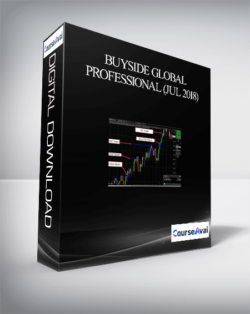 BuySide Global Professional (Jul 2018)
₹47,144.00
BuySide Global Professional (Jul 2018)
₹47,144.00
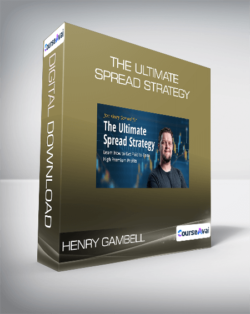 Henry Gambell – The Ultimate Spread Strategy
₹39,342.00
Henry Gambell – The Ultimate Spread Strategy
₹39,342.00
Wyckoff Analytics – Wyckoff Trading Course (WTC) Spring 2019
₹17,264.00

